Using Spatial Pattern Analysis to Explore the Relationship between Vulnerability and Resilience to Natural Hazards
Abstract
1. Introduction
2. Materials and Methods
2.1. Yilan County
2.2. SERV, Variables Selection, and PCA
2.3. Spatial Pattern Analysis and GWR
3. Results
3.1. Spatial Pattern of SERV
3.2. GWR
4. Discussion
5. Conclusions
Author Contributions
Funding
Institutional Review Board Statement
Informed Consent Statement
Data Availability Statement
Acknowledgments
Conflicts of Interest
References
- UNDP. Understanding Community Resilience: Findings from Community-Based Resilience Analysis (CoBRA) Assessments; UNDP: Nairobi, Kenya, 2014. [Google Scholar]
- Cutter, S.L. The landscape of disaster resilience indicators in the USA. Nat. Hazards 2016, 80, 741–758. [Google Scholar] [CrossRef]
- Frazier, T.G.; Thompson, C.M.; Dezzani, R.J.; Butsick, D. Spatial and temporal quantification of resilience at the community scale. Appl. Geogr. 2013, 42, 95–107. [Google Scholar] [CrossRef]
- Frigerio, I.; Ventura, S.; Strigaro, D.; Mattavelli, M.; Amicis, M.D.; Mugnano, S.; Boffi, M. A GIS-based approach to identify the spatial variability of social vulnerability to seismic hazard in Italy. Appl. Geogr. 2016, 74, 12–22. [Google Scholar] [CrossRef]
- Cutter, S.L.; Boruff, B.J.; Shirley, W.L. Social vulnerability to environmental hazards. Soc. Sci. Q. 2003, 84, 242–261. [Google Scholar] [CrossRef]
- Cutter, S.L. Vulnerability to environmental hazards. Prog. Hum. Geogr. 1996, 20, 529–539. [Google Scholar] [CrossRef]
- Adger, W.N. Vulnerability. Glob. Environ. Chang. 2006, 16, 268–281. [Google Scholar] [CrossRef]
- Cardona, O.D. Diagnóstico Local de Riesgos Naturales en Santa Fe de Bogotá Para la Planificación y Medidas de Mitigación. Panamericana-Secretarıá de Salud, Bogota. 1999. Available online: http://cidbimena.desastres.hn/docum/crid/Febrero2004/pdf/spa/doc12562/doc12562.htm (accessed on 28 April 2021).
- Cardona, O.D. Estimacio‘n Holı’stica del Riesgo Sı‘Smico Utilizando Sistemas Dina’micos Complejos. Ph.D. Thesis, Universitat Politècnica de Catalunya, Barcelona, Spain, 2001. Available online: http://www.desenredando.org/public/varios/2001/ehrisusd/index.html (accessed on 29 April 2021).
- Turner, B.L.; Kasperson, R.E.; Matson, P.A.; McCarthy, J.J.; Corell, R.W.; Christensen, L.; Eckley, N.; Kasperson, J.X.; Luers, A.; Martello, M.L.; et al. A framework for vulnerability analysis in sustainability science. Proc. Natl. Acad. Sci. USA 2003, 100, 8074–8079. [Google Scholar] [CrossRef]
- Bogardi, J.; Birkmann, J. Vulnerability assessment: The first step towards sustainable risk reduction. In Disasters and Society: From Hazard Assessment to Risk Reduction, 1st ed.; Logos Verlag Berlin: Berlin, Germany, 2006. [Google Scholar]
- Cardona, O.D. Indicators of Disaster Risk and Risk Management—Main Technical Report; Instituto De Estudios Ambientales (IDEA), Universidad Nacional de Colombia: Bogotá, Colombia, 2005. [Google Scholar]
- Birkmann, J. Measuring Vulnerability to Natural Hazards—Towards Disaster Resilient Societies; United Nations University Press: Tokyo, Japan, 2006. [Google Scholar]
- Carrenõ, M.L.; Cardona, O.D.; Barbat, A.H. Urban seismic risk evaluation: A holistic approach. Nat. Hazards 2007, 40, 137–172. [Google Scholar] [CrossRef]
- Zebardast, E. Constructing a social vulnerability index to earthquake hazards using a hybrid factor analysis and analytic network process (F’ANP) model. Nat. Hazards 2013, 65, 1331–1359. [Google Scholar] [CrossRef]
- Oliver-Smith, A. Theorizing vulnerability in a globalized world: A political ecological perspective. In Mapping Vulnerability: Disasters, Development and People, 1st ed.; Bankoff, G., Frerks, G., Hilhorst, D., Eds.; Routledge: London, UK, 2003. [Google Scholar]
- Cutter, S.L.; Finch, C. Temporal and spatial changes in social vulnerability to natural hazards. Proc. Natl. Acad. Sci. USA 2008, 105, 2301–2306. [Google Scholar] [CrossRef]
- Kuhlicke, C.; Scolobig, A.; Tapsell, S.; Steinführer, A.; de Marchi, B. Contextualizing social vulnerability: Findings from case studies across Europe. Nat. Hazards 2011, 58, 789–810. [Google Scholar] [CrossRef]
- Myers, C.A.; Slack, T.; Singelmann, J. Social vulnerability and migration in the wake of disaster: The case of hurricanes Katrina and Rita. Popul. Environ. 2008, 29, 271–291. [Google Scholar] [CrossRef]
- Qasim, S.; Qasim, M.; Shrestha, R.P.; Khan, A.N. Socioeconomic determinants of landslide risk perception in Murree hills of Pakistan. AIMS Environ. Sci. 2018, 5, 305–314. [Google Scholar] [CrossRef]
- Eidsvig, U.M.K.; McLean, A.; Vangelsten, B.V.; Kalsnes, B.; Ciurean, R.L.; Argyroudis, S.; Winter, M.G.; Mavrouli, O.C.; Fotopoulou, S.; Pitilakis, K.; et al. Assessment of socioeconomic vulnerability to landslides using an indicator-based approach: Methodology and case studies. Bull. Eng. Geol. Environ. 2014, 73, 307–324. [Google Scholar] [CrossRef]
- Alcorn, R.; Panter, K.S.; Gorsevski, P.V.A. GIS-based volcanic hazard and risk assessment of eruptions sourced within Valles Caldera, New Mexico. J. Volcanol. Geoth. Res. 2013, 267, 1–14. [Google Scholar] [CrossRef][Green Version]
- Zhou, Y.; Li, N.; Wu, W.; Wu, J.; Shi, P. Local spatial and temporal factors influencing population and societal vulnerability to natural disasters. Risk Anal. 2014, 34, 614–639. [Google Scholar] [CrossRef]
- Birkmann, J.; Cardona, O.D.; Carreño, M.L.; Barbat, A.H.; Pelling, M.; Schneiderbauer, S.; Kienberger, S.; Keiler, M.; Alexander, D.; Zeil, P.; et al. Framing vulnerability, risk and societal responses: The MOVE framework. Nat. Hazards 2013, 67, 193–211. [Google Scholar] [CrossRef]
- Birkmann, J. Regulation and coupling of society and nature in the context of natural hazards. In Coping with Global Environmental Change, Disasters and Security: Threats, Challenges, Vulnerabilities and Risks, 1st ed.; Brauch, H.G., Spring, Ú.O., Mesjasz, C., Grin, J., Kameri-Mbote, P., Chourou, B., Dunay, P., Birkmann, J., Eds.; Springer: Berlin/Heidelberg, Germany, 2011. [Google Scholar]
- Pelling, M. Adaptation to Climate Change: From Resilience to Transformation; Routledge: London, UK, 2010. [Google Scholar]
- Cutter, S.L.; Ash, K.D.; Emrich, C.T. The geographies of community disaster resilience. Glob. Environ. Chang. 2014, 29, 65–77. [Google Scholar] [CrossRef]
- Doorn, N. Resilience indicators: Opportunities for including distributive justice concerns in disaster management. J. Risk Res. 2015, 20, 711–731. [Google Scholar] [CrossRef]
- Cutter, S.L.; Barnes, L.; Berry, M.; Burton, C.; Evans, E.; Tate, E.; Webb, J. A place-based model for understanding community resilience to natural disasters. Glob. Environ. Chang. 2008, 18, 598–606. [Google Scholar] [CrossRef]
- Manyena, S.B. The concept of resilience revisited. Disasters 2006, 30, 433–450. [Google Scholar] [CrossRef]
- Yoon, D.K.; Kang, J.E.; Brody, S.D. A measurement of community disaster resilience in Korea. J. Environ. Plann. Man. 2016, 59, 436–460. [Google Scholar] [CrossRef]
- Norris, F.H.; Stevens, S.P.; Pfefferbaum, B.; Wyche, K.F.; Pfefferbaum, R.L. Community resilience as a metaphor, theory, set of capacities, and strategy for disaster readiness. Am. J. Commun. Psychol. 2008, 41, 127–150. [Google Scholar] [CrossRef]
- Twigger-Ross, C.; Coates, T.; Deeming, H.; Orr, P.; Ramsden, M.; Stafford, J. Community Resilience Research: Final Report on Theoretical Research and Analysis of Case Studies Report to the Cabinet Office and Defence Science and Technology Laboratory; Collingwood Environmental Planning Ltd.: London, UK, 2011. [Google Scholar]
- Barnett, J. Adapting to climate change in Pacific island countries: The problem of uncertainty. World Dev. 2001, 29, 977–993. [Google Scholar] [CrossRef]
- Jordan, E.; Javernick-Will, A. Indicators of community recovery: Content analysis and delphi approach. Nat. Hazards Rev. 2013, 14, 21–28. [Google Scholar] [CrossRef]
- Lee, Y.J. Social vulnerability indicators as a sustainable planning tool. Environ. Impact Asses. 2014, 44, 31–42. [Google Scholar] [CrossRef]
- Frigerio, I.; Amicis, M.D. Mapping social vulnerability to natural hazards in Italy: A suitable tool for risk mitigation strategies. Environ. Sci. Policy 2016, 63, 187–196. [Google Scholar] [CrossRef]
- Adger, W.N.; Brooks, N.; Bentham, G.; Agnew, M.; Eriksen, S. New Indicators of Vulnerability and Adaptive Capacity; Tyndall Centre for Climate Change Research: Norwich, UK, 2004. [Google Scholar]
- Winderl, T. Disaster Resilience Measurements: Stocktaking of Ongoing Efforts in Developing System for Measuring Resilience; UNDP: Nairobi, Kenya, 2014. [Google Scholar]
- Frazier, T.G.; Thompson, C.M.; Dezzani, R.J. A framework for the development of the SERV model: A spatially explicit resilience-vulnerability model. Appl. Geogr. 2014, 52, 158–172. [Google Scholar] [CrossRef]
- Cerchiello, V.; Ceresa, P.; Monteiro, R.; Komendantova, N. Assessment of social vulnerability to seismic hazard in Nablus, Palestine. Int. J. Disast. Risk Reduct. 2018, 28, 491–506. [Google Scholar] [CrossRef]
- Török, I. Qualitative assessment of social vulnerability to flood hazards in Romania. Sustainability 2018, 10, 3780. [Google Scholar] [CrossRef]
- Fatemi, F.; Ardalan, A.; Aguirre, B.; Mansouri, N.; Mohammadfam, I. Social vulnerability indicators in disasters: Findings from a systematic review. Int. J. Disast. Risk Reduct. 2017, 22, 219–227. [Google Scholar] [CrossRef]
- Rabby, Y.W.; Hossain, M.B.; Hasan, M.U. Social vulnerability in the coastal region of Bangladesh: An investigation of social vulnerability index and scalar change effects. Int. J. Disast. Risk Reduct. 2019, 41, 101329. [Google Scholar] [CrossRef]
- Kurnianto, F.A.; Ikhsan, F.A.; Apriyanto, B.; Nurdin, E.A. Earthquake vulnerability disaster in the Lembang district of West Bandung Regency, Indonesia. Earthq. Sci. 2019, 32, 40–46. [Google Scholar] [CrossRef]
- Yuan, H.H.; Gao, X.L.; Qi, W. Fine-scale spatiotemporal analysis of population vulnerability to earthquake disasters: Theoretical models and application to cities. Sustainability 2019, 11, 2149. [Google Scholar] [CrossRef]
- Gu, H.; Du, S.; Liao, B.; Wen, J.; Wang, C.; Chen, R.; Chen, B. A hierarchical pattern of urban social vulnerability in Shanghai, China and its implications for risk management. Sustain. Cities Soc. 2018, 41, 170–179. [Google Scholar] [CrossRef]
- Hadipour, V.; Vafaie, E.; Kerle, N. An indicator-based approach to assess social vulnerability of coastal areas to sea-level rise and flooding: A case study of Bandar Abbas city, Iran. Ocean Coast. Manag. 2020, 188, 105077. [Google Scholar] [CrossRef]
- Peacock, W.G.; Morrow, B.H.; Gladwin, H. Hurricane Andrew: Ethnicity, Gender and the Sociology of Disaster; Routledge: London, UK, 1997. [Google Scholar]
- Fothergill, A. Gender, risk and disaster. Int. J. Mass Emergencies Disasters 1996, 14, 33–56. [Google Scholar]
- Hung, L.S.; Wang, C.; Yarnal, B. Vulnerability of families and households to natural hazards: A case study of storm surge flooding in Sarasota county, Florida. Appl. Geogr. 2016, 76, 184–197. [Google Scholar] [CrossRef]
- Bereitschaft, B. Equity in microscale urban design and walkability: A photographic survey of six Pittsburgh streetscapes. Sustainability 2017, 9, 1233. [Google Scholar] [CrossRef]
- Contreras, D. The integrated spatial pattern of child mortality during the 2012–2016 drought in La Guajira, Colombia. Sustainability 2019, 11, 7190. [Google Scholar] [CrossRef]
- Phama, N.T.T.; Nongc, D.; Sathyand, A.R.; Garschagene, M. Vulnerability assessment of households to flash floods and landslides in the poor upland regions of Vietnam. Clim. Risk Manag. 2020, 28, 100215. [Google Scholar] [CrossRef]
- Fothergill, A.; Maestas, E.G.M.; Darlington, J.D. Race, ethnicity, and disasters in the United States: A review of the literature. Disasters 1999, 23, 156–173. [Google Scholar] [CrossRef] [PubMed]
- Wood, N.; Church, A.; Frazier, T.; Yarnal, B. Variations in community exposure and sensitivity to tsunami hazards in the State of Hawaíi. In Scientific Investigation Report 2007–5208; U.S. Geological Survey; USGS: Reston, VA, USA, 2007. [Google Scholar]
- Contreras, D.; Kienberger, S. GIS in the vulnerability assessment and recovery process in a community with elderly and disabled people after a disaster. In Rebuilding Sustainable Communities with Vulnerable Populations after the Cameras Have Gone: A Worldwide Study; Awotona, A., Ed.; Cambridge Scholar Publishing: Cambridge, UK, 2012. [Google Scholar]
- Karakoc, D.B.; Barker, K.; Zobelb, C.W.; Almoghathawic, Y. Social vulnerability and equity perspectives on interdependent infrastructure network component importance. Sustain. Cities Soc. 2020, 57, 102072. [Google Scholar] [CrossRef]
- Wang, C.; Yarnal, B. The vulnerability of the elderly to hurricane hazards in Sarasota, Florida. Nat. Hazards 2012, 63, 349–373. [Google Scholar] [CrossRef]
- Flores, A.B.; Collins, T.W.; Grineski, S.E.; Chakraborty, J. Social vulnerability to hurricane Harvey: Unmet needs and adverse event experiences in Greater Houston, Texas. Int. J. Disast. Risk Reduct. 2020, 46, 101521. [Google Scholar] [CrossRef]
- Guoa, X.; Kapucu, N. Assessing social vulnerability to earthquake disaster using rough analytic hierarchy process method: A case study of Hanzhong City, China. Safety Sci. 2020, 125, 104625. [Google Scholar] [CrossRef]
- Morimoto, T. Spatial analysis of social vulnerability to floods based on the MOVE framework and information entropy method: Case study of Katsushika Ward, Tokyo. Sustainability 2019, 11, 529. [Google Scholar] [CrossRef]
- Sajaa, A.M.A.; Goonetillekea, A.; Teoa, M.; Ziyatha, A.M. A critical review of social resilience assessment frameworks in disaster management. Int. J. Disast. Risk Reduct. 2019, 35, 10196. [Google Scholar] [CrossRef]
- Caia, H.; Lama, N.S.N.; Qiangb, Y.; Zoua, L.; Corrella, R.M.; Mihunova, V. A synthesis of disaster resilience measurement methods and indices. Int. J. Disast. Risk Reduct. 2018, 31, 844–855. [Google Scholar] [CrossRef]
- Scherzera, S.; Lujalab, P.; Røda, J.K. A community resilience index for Norway: An adaptation of the baseline resilience indicators for communities (BRIC). Int. J. Disast. Risk Reduct. 2019, 36, 101107. [Google Scholar] [CrossRef]
- Cutter, S.L.; Ash, K.D.; Emrich, C.T. Uraster resilience. Ann. Am. Assoc. Geogr. 2016, 106, 1236–1252. [Google Scholar]
- Ross, A.D. Local Disaster Resilience: Administrative and Political Perspectives; Routledge: London, UK, 2014. [Google Scholar]
- Aldrich, D.P.; Meyer, M.A. Social capital and community resilience. Am. Behav. Sci. 2015, 59, 254–269. [Google Scholar] [CrossRef]
- Aldrich, D.P. Social, not physical, infrastructure: The critical role of civil society in disaster recovery. Disasters 2012, 36, 398–419. [Google Scholar] [CrossRef]
- Peacock, W.G.; Brody, S.D.; Seitz, W.A.; Merrell, W.J.; Vedlitz, A.; Zahran, S.; Harriss, R.C.; Stickney, R. Advancing Resilience of Coastal Localities: Developing, Implementing, and Sustaining the Use of Coastal Resilience Indicators: A Final Report; NOAA: Washington, DC, USA, 2010.
- Cutter, S.L.; Burton, C.G.; Emrich, C.T. Disaster resilience indicators for benchmarking baseline conditions. J. Homel. Secur. Emerg. 2010, 7, 1–22. [Google Scholar] [CrossRef]
- Kwok, A.H.; Doyle, E.E.H.; Becker, J.; Johnston, D.; Paton, D. What is ‘social resilience’? Perspectives of disaster researchers, emergency management practitioners, and policymakers in New Zealand. Int. J. Disast. Risk Reduct. 2016, 19, 197–211. [Google Scholar] [CrossRef]
- Moran, P.A.P. The interpretation of statistical maps. J. R. Stat. Soc. 1948, 10, 243–251. [Google Scholar] [CrossRef]
- Moran, P.A.P. Notes on continuous stochastic phenomena. Biometrika 1950, 37, 17–23. [Google Scholar] [CrossRef]
- Anselin, L. Local indicators of spatial association-Lisa. Geogr. Anal. 1997, 27, 93–115. [Google Scholar] [CrossRef]
- Yee, L.; Mei, C.L.; Zhang, W.X. Statistical tests for spatial nonstationarity based on the geographically weighted regression model. Environ. Plann. A 2000, 32, 9–32. [Google Scholar]
- Brunsdon, C.; Fotheringham, A.; Charlton, M. Geographically weighted regression: A method for exploring spatial nonstationarity. Geogr. Anal. 1996, 28, 281–298. [Google Scholar] [CrossRef]
- Fotheringham, A.; Charlton, M.; Brunsdon, C. Geographically weighted regression: A natural evolution of the expansion method for spatial data analysis. Environ. Plann. A 1998, 30, 1905–1927. [Google Scholar] [CrossRef]
- Fotheringham, A.; Brunsdon, C.; Charlton, M. Geographically Weighted Regression: The Analysis of Spatially Varying Relationship; Wiley: Hoboken, NJ, USA, 2003. [Google Scholar]
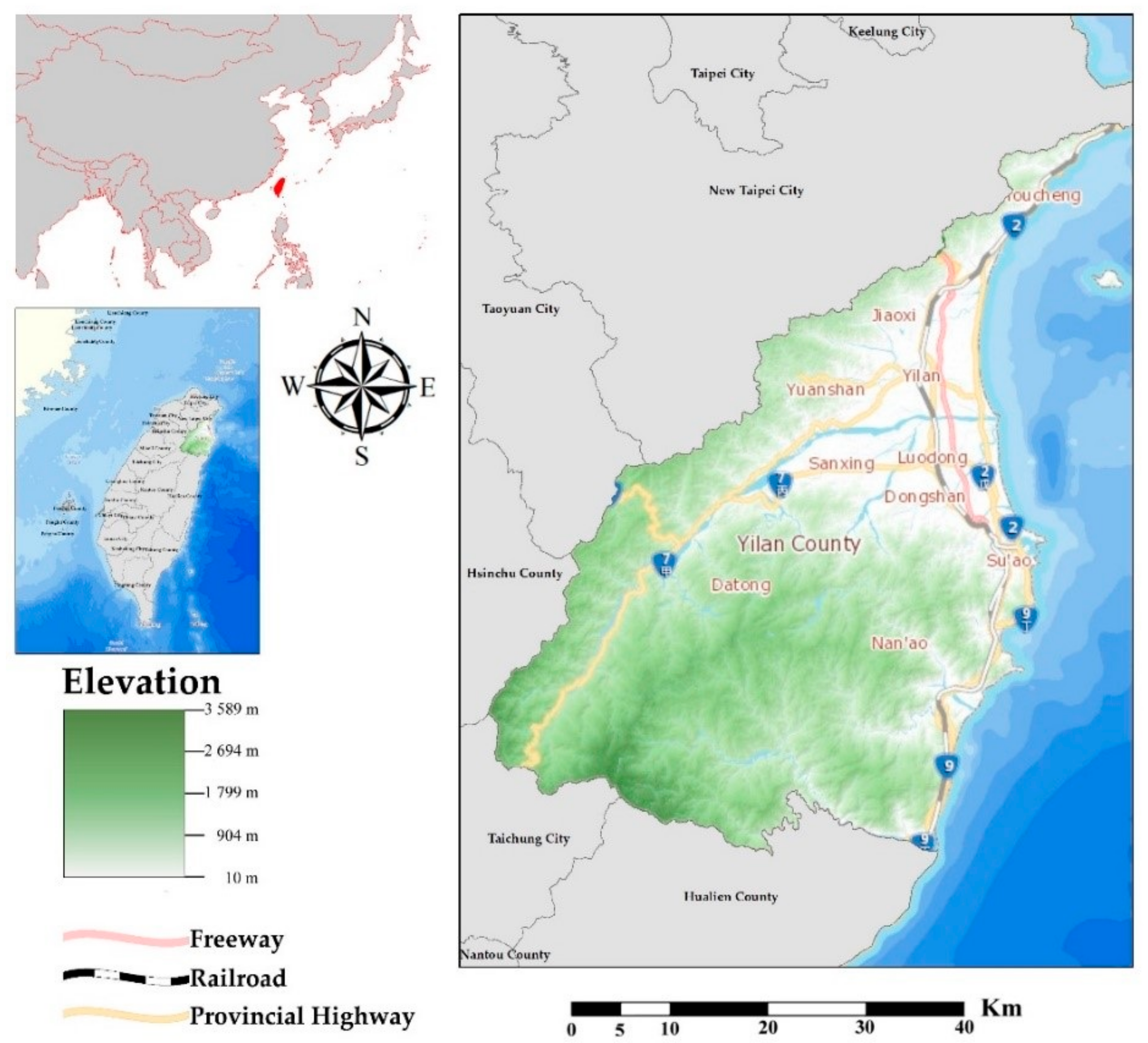
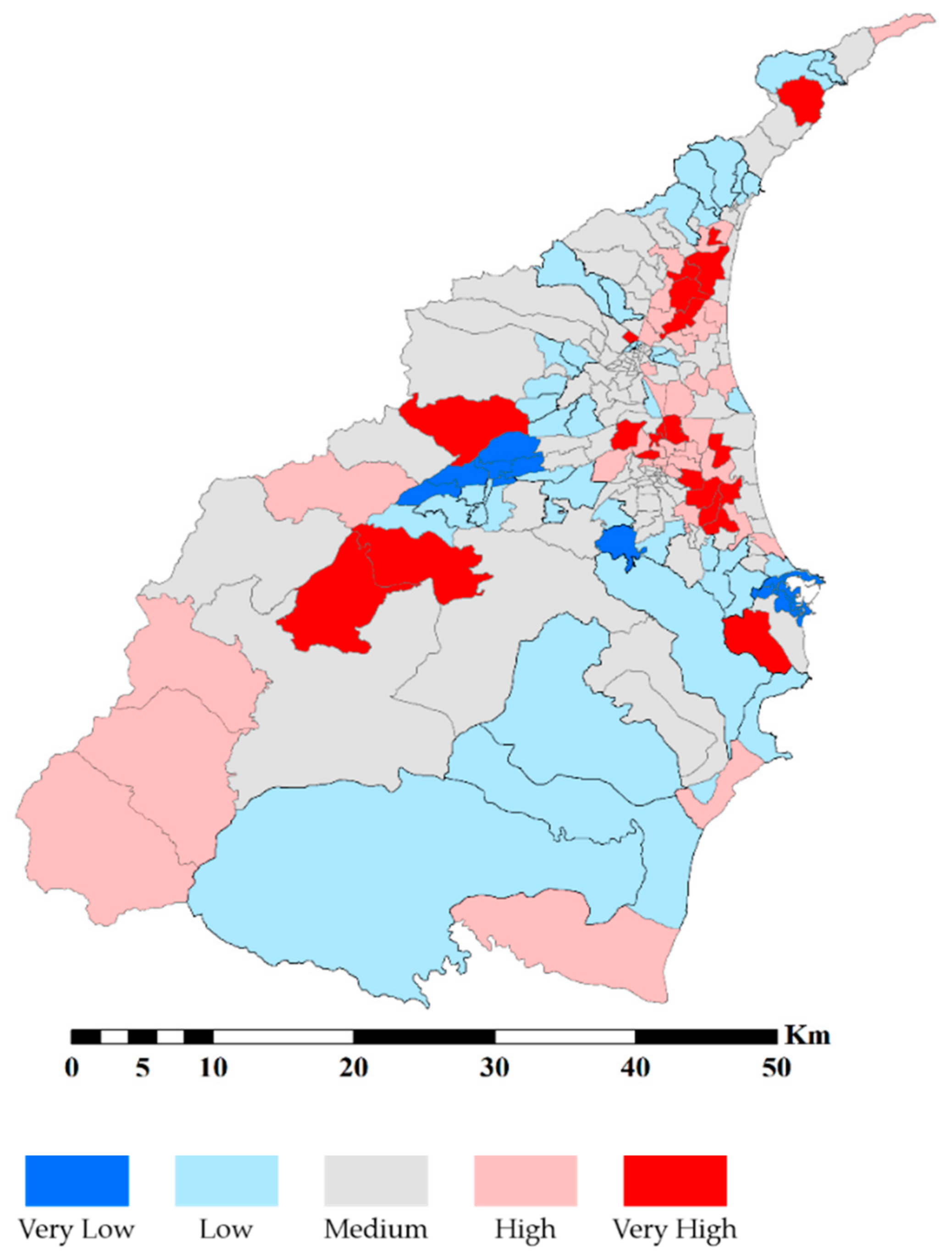
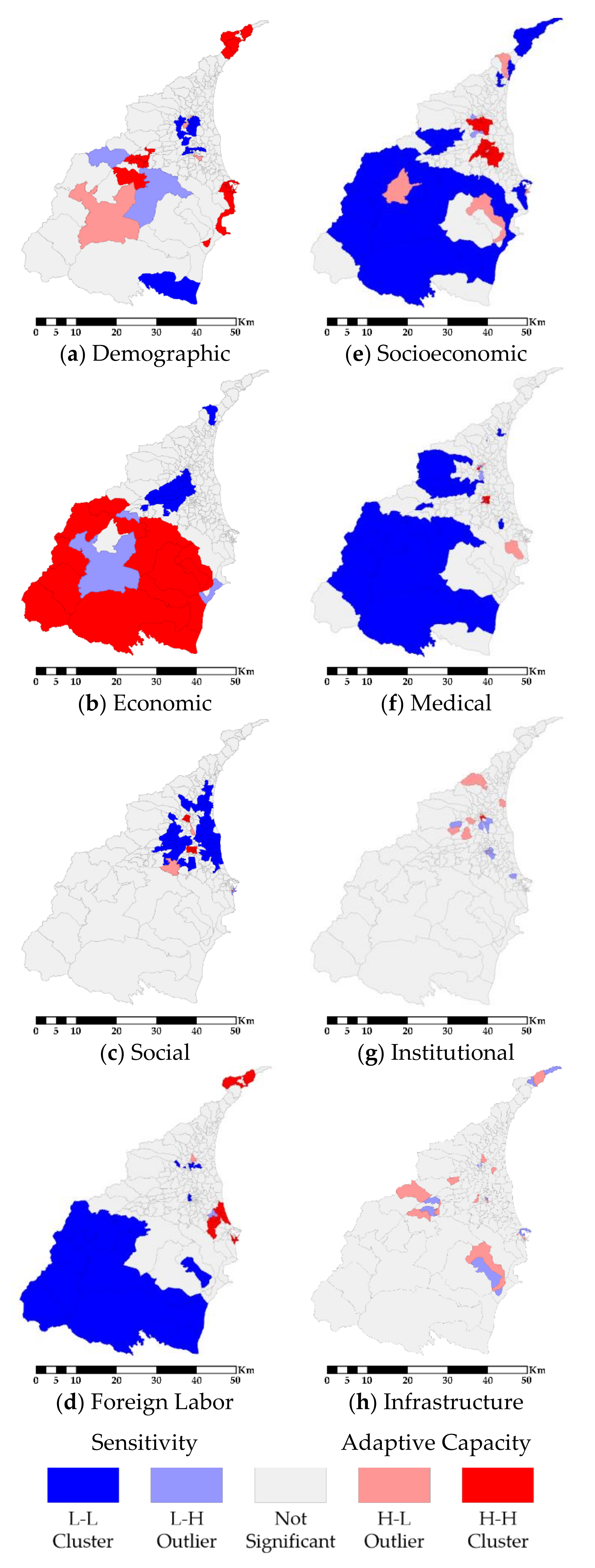
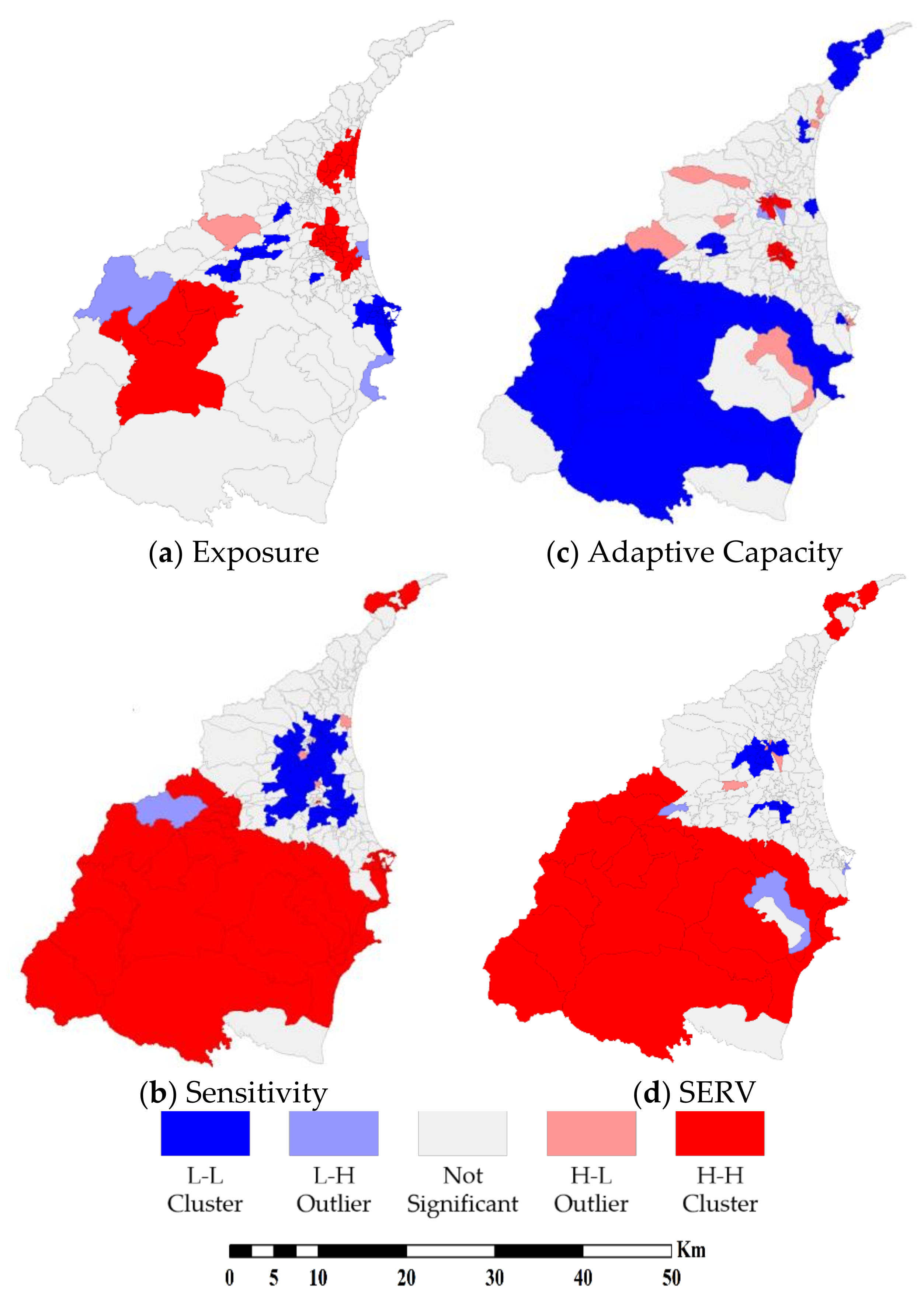
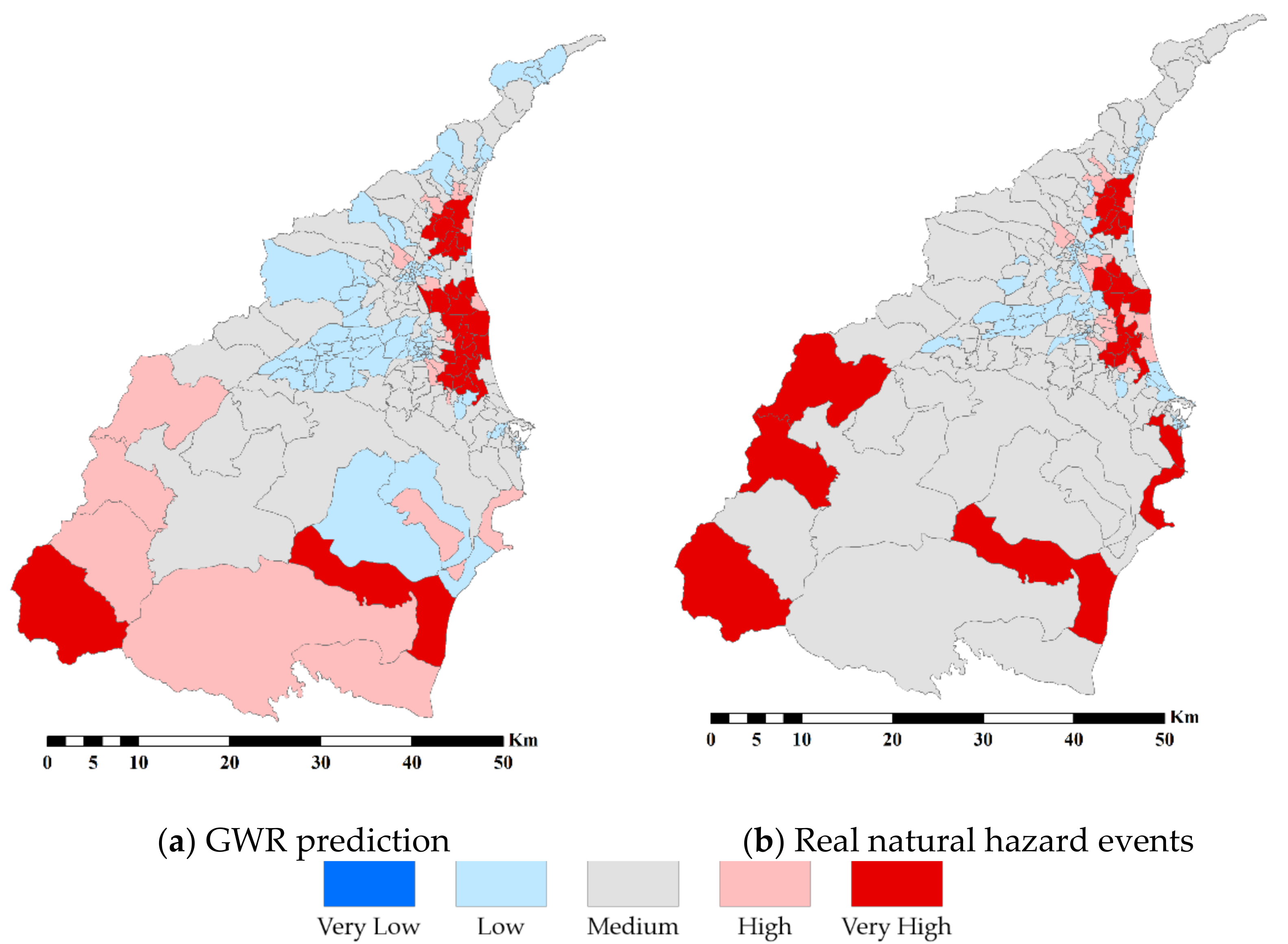
| Indicators and Variables of Sensitivity | Moran’s I | p-Value |
|---|---|---|
| Population Density | 0.634 | <0.05 |
| Standardized Female Population | 0.582 | <0.05 |
| Middle/Low-income (MLI) Household | 0.488 | <0.05 |
| Dependency Ratio | 0.420 | <0.05 |
| Foreign Residents and Laborers | 0.244 | <0.05 |
| Indigenous Population Ratio | 0.650 | <0.05 |
| Solitary Elderly Population | 0.197 | <0.05 |
| Physically and Mentally Challenged Population | 0.198 | <0.05 |
| Children < 5 Years Old | 0.433 | <0.05 |
| Elderly > 65 Years Old | 0.337 | <0.05 |
| Aging Index | 0.107 | <0.05 |
| Population without High School Diploma | 0.706 | <0.05 |
| Indicators and Variables of Adaptive Capacity | Moran’s I | p-Value |
|---|---|---|
| Annual Income | 0.365 | <0.05 |
| Population with a College Diploma | 0.556 | <0.05 |
| Working Population | 0.277 | <0.05 |
| Voter | 0.388 | <0.05 |
| Number of Social-Civic Groups | 0.124 | <0.05 |
| Capacity of Emergency Shelters | 0.063 | 0.10 |
| Number of Healthcare Facilities | 0.407 | <0.05 |
| Number of Licensed Medical Personnel | 0.017 | 0.41 |
| Number of Hospital Beds | −0.013 | 0.81 |
| Number of Pharmacies | 0.283 | <0.05 |
| Number of Emergency Services Stations | −0.068 | 0.12 |
| Number of Ambulances | −0.018 | 0.69 |
| Component | KMO | p-Value of Bartlett’s Test of Sphericity | Total Variables Explained |
|---|---|---|---|
| Sensitivity | 0.647 | <0.05 | 77% |
| Adaptive capacity | 0.622 | <0.05 | 65% |
| Sensitivity | |||
|---|---|---|---|
| Component | Moran’s I | p-Value | Domain |
| Principal component (a) | 0.335 | <0.05 | Demographic |
| Principal component (b) | 0.584 | <0.05 | Economic |
| Principal component (c) | 0.594 | <0.05 | Social |
| Principal component (d) | 0.224 | <0.05 | Foreign Labor |
| Adaptive capacity | |||
| Component | Moran’s I | p-Value | Domain |
| Principal component (e) | 0.563 | <0.05 | Socioeconomic |
| Principal component (f) | 0.286 | <0.05 | Medical |
| Principal component (g) | 0.002 | 0.83 | Institutional |
| Principal component (h) | −0.052 | 0.18 | Infrastructure |
| Component | Moran’s I | p-Value |
|---|---|---|
| Exposure (E) | 0.477 | <0.05 |
| Sensitivity (S) | 0.584 | <0.05 |
| Adaptive Capacity (AC) | 0.406 | <0.05 |
| SERV ([E+S]-AC) | 0.414 | <0.05 |
| Neighbors | R2 | Adjusted R2 | Moran’s I of StdResid | The p-Value of Moran’s I |
|---|---|---|---|---|
| 31 | 0.696 | 0.501 | −0.055 | 0.194 |
Publisher’s Note: MDPI stays neutral with regard to jurisdictional claims in published maps and institutional affiliations. |
© 2021 by the authors. Licensee MDPI, Basel, Switzerland. This article is an open access article distributed under the terms and conditions of the Creative Commons Attribution (CC BY) license (https://creativecommons.org/licenses/by/4.0/).
Share and Cite
Sung, C.-H.; Liaw, S.-C. Using Spatial Pattern Analysis to Explore the Relationship between Vulnerability and Resilience to Natural Hazards. Int. J. Environ. Res. Public Health 2021, 18, 5634. https://doi.org/10.3390/ijerph18115634
Sung C-H, Liaw S-C. Using Spatial Pattern Analysis to Explore the Relationship between Vulnerability and Resilience to Natural Hazards. International Journal of Environmental Research and Public Health. 2021; 18(11):5634. https://doi.org/10.3390/ijerph18115634
Chicago/Turabian StyleSung, Chien-Hao, and Shyue-Cherng Liaw. 2021. "Using Spatial Pattern Analysis to Explore the Relationship between Vulnerability and Resilience to Natural Hazards" International Journal of Environmental Research and Public Health 18, no. 11: 5634. https://doi.org/10.3390/ijerph18115634
APA StyleSung, C.-H., & Liaw, S.-C. (2021). Using Spatial Pattern Analysis to Explore the Relationship between Vulnerability and Resilience to Natural Hazards. International Journal of Environmental Research and Public Health, 18(11), 5634. https://doi.org/10.3390/ijerph18115634






